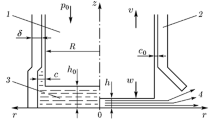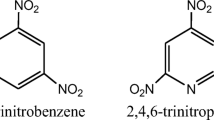Abstract
This paper studies the detonability of low-sensitivity multicomponent explosive formulations based on RDX or HMX containing 12–20% polymer binder and, if necessary, ammonium perchlorate and aluminum. An analytical dependence of the critical diameter of low-sensitivity charges on the content of the explosive component is obtained based on the theory of the critical detonation diameter of nonuniform high-density explosive charges developed earlier by the author. The effect of the particle size of the explosive component on the critical diameter is discussed. For a 5–70% content of the explosive component, satisfactory agreement with available experimental data is obtained.
Similar content being viewed by others
References
V. P. I’in, E. V. Kolganov, S. P. Smirnov, et al., “Analysis of the state of affairs of developments of low-sensitivity explosive formulations in our country and abroad,” in: III Interindustrial Conf. Topical Problems and Prospects of Development of Low-Sensitivity Energetic Materials and Lower-Risk Products, GosNII, Kristall, Dzerzhinsk (2007).
P. P. Vadhe, R. B. Pawar, R. K. Sinha, S. N. Asthana, A. Subhananda Rao, “Cast aluminized explosives (review),” Combust., Expl., Shock Waves, 44, No. 4, 461–477 (2008).
B. P. Zhukov (ed.), Energetic Condensed Systems: Brief Encyclopedic Handbook [in Russian], Yanus-K, Moscow (1999).
K. P. Stanyukovich, Physics of Explosion [in Russian], Nauka, Moscow (1975).
I. F. Kobylkin, V. S. Solovev, and M. M. Boiko, “Critical diameter for stationary detonation in a high density explosive: Shell effect,” Combust., Expl., Shock Waves, 19, No. 4, 484–487 (1983).
L. P. Orlenko, Physics of Explosion [in Russian], Vol. 1, Fizmatlit, Moscow (2002).
I. F. Kobylkin, “Calculation of critical detonation diameter of explosive charges using data on their shockwave initiation,” Combust., Expl., Shock Waves, 42, No. 2, 223–226 (2006).
B. M. Dobratz (ed.), Properties of Chemical Explosives and Explosive Simulants, Lawrence Livermore Laboratory, Livermore (1981).
E. Anderson, “Explosives,” in: J. Carleone (ed.) Tactical Missile Warheads, AIAA, Washington (1993), pp. 81–158.
B. A. Khasainov, B. S. Ermolaev, H. N. Presles, and P. Vidal, “On the effect of grain size on shock sensitivity of heterogeneous high explosives,” Shock Waves, 7 (1997).
G. Bocksteiner, M. G. Wolfson, and D. J. Whelan, “The critical diameter, detonation velocity and shock sensitivity of Australian PBXW-115,” in: Defense Science and Technology Organization, Australia (1994). DSTO-19950214081.
S. M. Caulder, P. J. Miller, and J. M. Kelley, “Effect of particle-size and crystal quality on the critical shock initiation pressure of RDX/HTPB formulations,” in: 13th Int. Detonation Symp., Norfolk (2006).
V. Yu. Klimenko, A. L. Krivchenko, and A. A. Krivchenko, “The mechanism of shock-wave initiation of RDX with various fillers,” in: Conf. Shock Waves in Condensed Media, St. Petersburg (2008), pp. 199–208.
A. M. Weston, J. F. Kinkaid, E. James, E. L. Lee, L. G. Green, and J. R. Walton, “Correlation of the results of initiation tests,” in: 7th Symp. (Int.) on Detonation, Washington (1981).
Author information
Authors and Affiliations
Corresponding author
Additional information
__________
Translated from Fizika Goreniya i Vzryva, Vol. 45, No. 6, pp. 108–114, November–December, 2009.
Rights and permissions
About this article
Cite this article
Kobylkin, I.F. Critical detonation diameter of highly desensitized low-sensitivity explosive formulations. Combust Explos Shock Waves 45, 732–737 (2009). https://doi.org/10.1007/s10573-009-0091-8
Received:
Revised:
Published:
Issue Date:
DOI: https://doi.org/10.1007/s10573-009-0091-8




